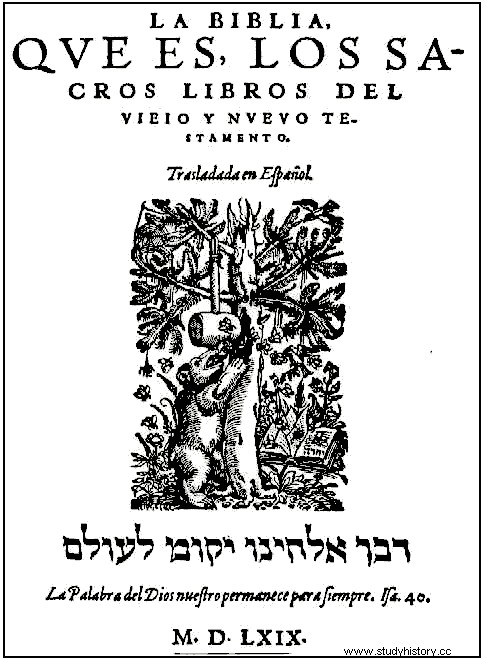
For centuries partial translations were carried out to Spanish from the Latin translation. Worthy of mention is the Alfonsine Bible , translated into Spanish from the Latin Vulgate in the year 1280 of our era by order of King Alfonso X. To carry out the translation into Spanish from Latin had to lose along the way some words and concepts written in the original languages when carrying out the translation into Spanish of another translation. There was still no complete translation of the Bible into Spanish from the original languages. All that changed in the 16th century when a young man named Cassiodorus of Queen entered the scene.
Who was Cassiodorus of Queen?
Casiodoro de Reina[1] was born in 1520 in Montemolín, present-day Badajoz (Spain), which at that time belonged to the Kingdom of Seville[ In addition to reading the Bible, Cassiodorus made a vow to translate it into his vernacular so that every Spanish could read it in Spanish. Something that was still not possible.
At about the age of 26, Cassiodorus entered the Monastery of St. Isidore of the Field of the order of the Jeromeans. During the 16th century in the monastery of San Isidoro del Campo[3] the study of the teachings of the Bible developed. Most of the monks of that extraordinary convent devoted more hours to the reading of the Scriptures than to their canonical duties. The study of the Bible modified their views, so that they rejected certain Catholic doctrines such as the veneration of images and the belief in purgatory. Cyprian of Valera, a companion and friend of Cassiodorus de Reina, said later of said monastery that “If God ever shows mercy to Seville, it will be reason that this monastery of San Isidoro del Campo becomes a University”[4].
That everyone can read the Bible in Spanish
For centuries there had been Bibles in Latin, but this was the language of the privileged , not of the common people. Cassiodorus believed that the whole world should understand the Scriptures, so he risked his life to achieve his goal, to translate the Bible into Spanish for the first time. The Holy Inquisition repressed the least atisbo of heterodoxy, so that Cassiodorus' desire to translate the Bible into Spanish would endanger not only his life, but that of his friends and collaborators.
At the end of 1557 a man who, by mistake, received a “suspicious” book from the hands of Julián Hernández (Julianillo)[5], unleashed the inquisitorial persecution on the monks of St. Isidore of the Field and the flight of some of them to Geneva (Switzerland). At least eleven monks managed to escape from the monastery of San Isidoro del Campo along with Cassiodorus. In the register book of the inhabitants of Geneva of those years it is noted that on October 14, 1557, four Seville immigrants were registered; on Oct. 10, 1558, nine immigrants more. As the Inquisition failed to capture Cassiodorus de Reina before his escape, he was burnt in effigy in an auto de fe in 1562 in Seville.
The Bear Bible
On September 28, 1569, Cassiodorus of Reina, aged about 49, published in Basel (Switzerland) the Bear Bible the first complete translation from the Bible into Spanish. He did it without mentioning the translator or the place of printing. It is so called because of the cover image of a bear trying to catch a honeycomb[6]. It was the result of ten years of hard work, difficulties with funding, continuous escapes to different countries and having received several accusations. He seems to have done most of the translation alone.

Subsequently, in 1602, his escape companion since the monastery of San Isidoro del Campo, Cipriano de Valera, published the first revision of Cassiodorus de Reina's translation, the so-called Bible of the Cantaloupe . . . . Later reviews came to be known as Reina-Valera by their surnames.
Antonio Muñoz Molina, an academic at the Royal Spanish Academy, defined the Bear Bible as “the hidden masterpiece”[7] and asked, what would English literature have been without the King James Bible? A great deal of English literature would not exist. The same would happen with the Spanish language without the Bear Bible . . . . Would you be willing to have a life on the constant run for wanting to translate the Bible into Spanish for the first time? Cassiodorus of Queen and his collaborators did so.
Bibliography
- Exhibition:“The Bear Bible. 450 years of the first Spanish translation of the Bible”. From 15 September to 15 December 2018. Faculty Philology. University of Seville (Spain).
- “Casiodorus of Queen. Freedom and Tolerance in Sixteenth-Century Europe”. 2017. Center for Andalucian Studies.
- “Arts of the Spanish Inquisition”. 2010. Almuzara
- “Casiodorus of Queen. Spanish Reformers of the Sixteenth Century”. 1975. Boydell Brewer
[1] Portrait of “Queen Cassiodorus”
[2] In the dedication written by Cassiodorus de Reina with his fist and letter in the volume of the Bear Bible to the senate of the city of Basel in June 1570 he is declared “hispanus hispalensis” (Hispanic Spanish). ”Casiodorus of Queen. Freedom and Tolerance in Sixteenth-Century Europe”. 2017. Center for Andalucian Studies. P. 11
[3] Photo “St. Isidore of the Field Monastery”
[4] “Arts of the Spanish Inquisition”. 2010. Almuzara. P. 21
[5] Julian Hernandez, Julianillo, was born in Villaverde, Castile, spent his childhood in Germany, where he met the reformist movement. It seems to have had a small body and lively and restless character. Disguised as an arriero, he clandestinely introduced books, manuscripts and letters that kept in touch with Spanish Protestants in exile and those who had remained in Spain. He was condemned to be burnt alive by the Inquisition in the auto de faith of December 22, 1560 qualified as a heretic, apostate, contumacious and dogmatizing.
[6] Cover image of the Bear Bible
[7] “The Country” – 23/07/2014 – https://thecountry. P>
